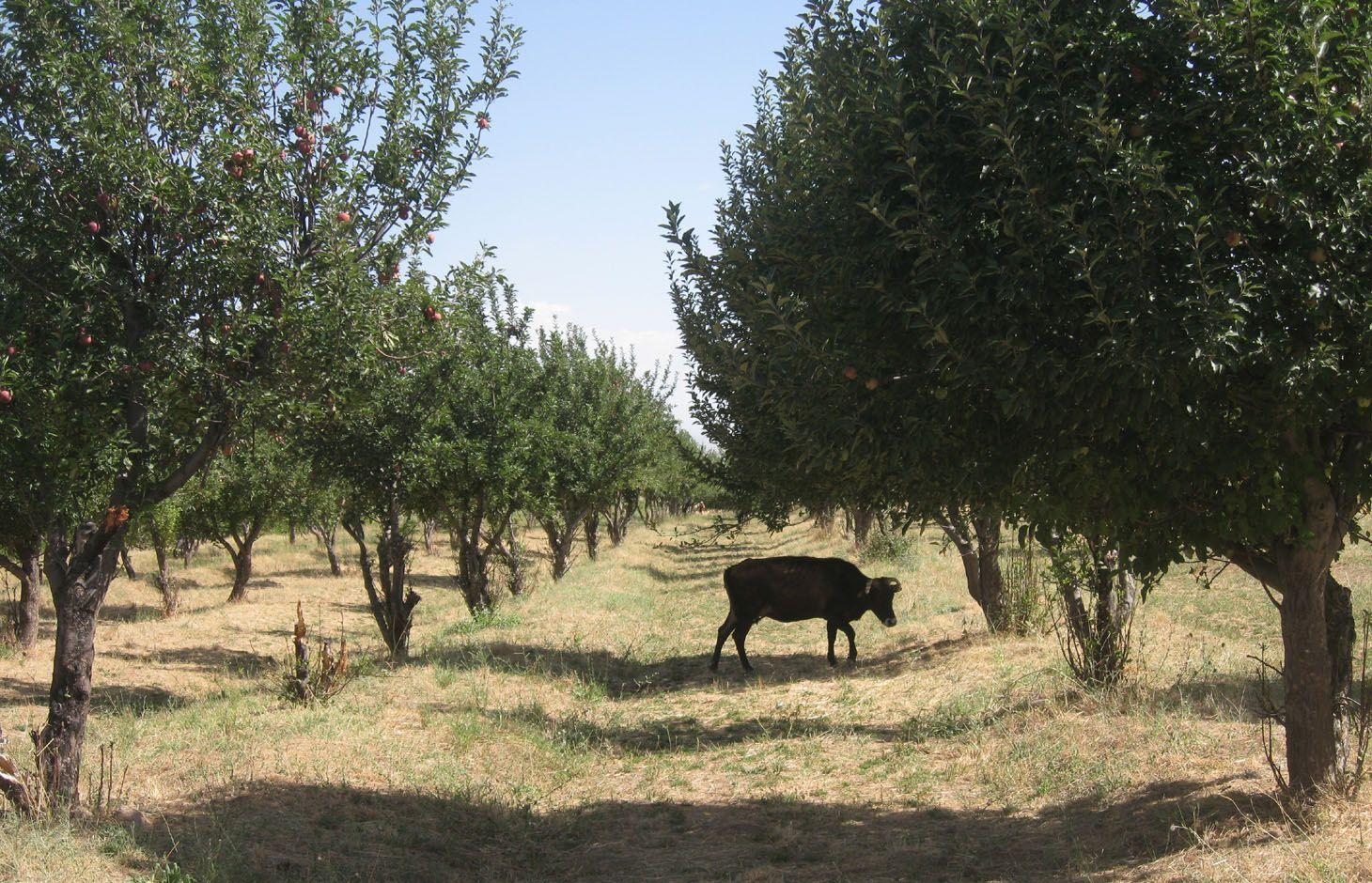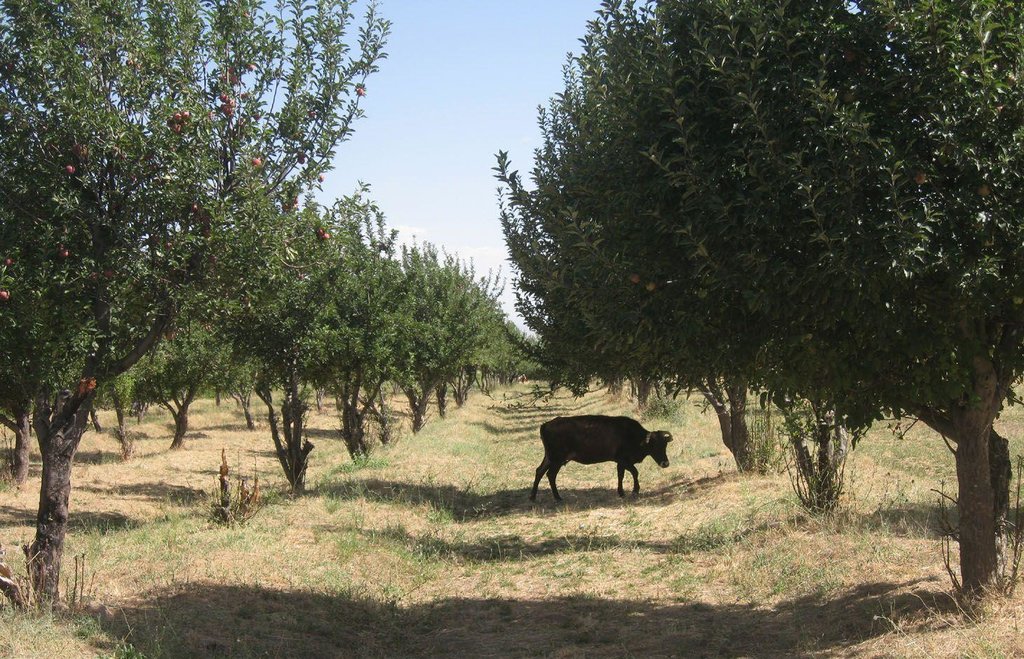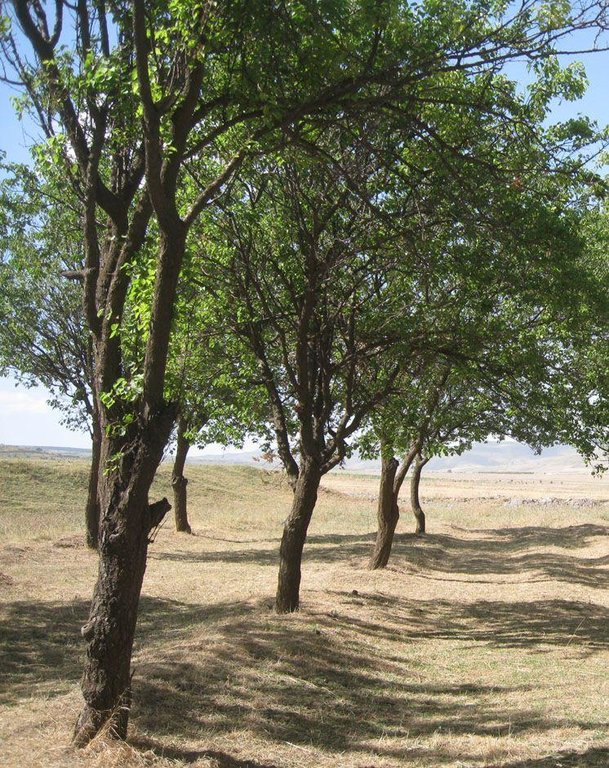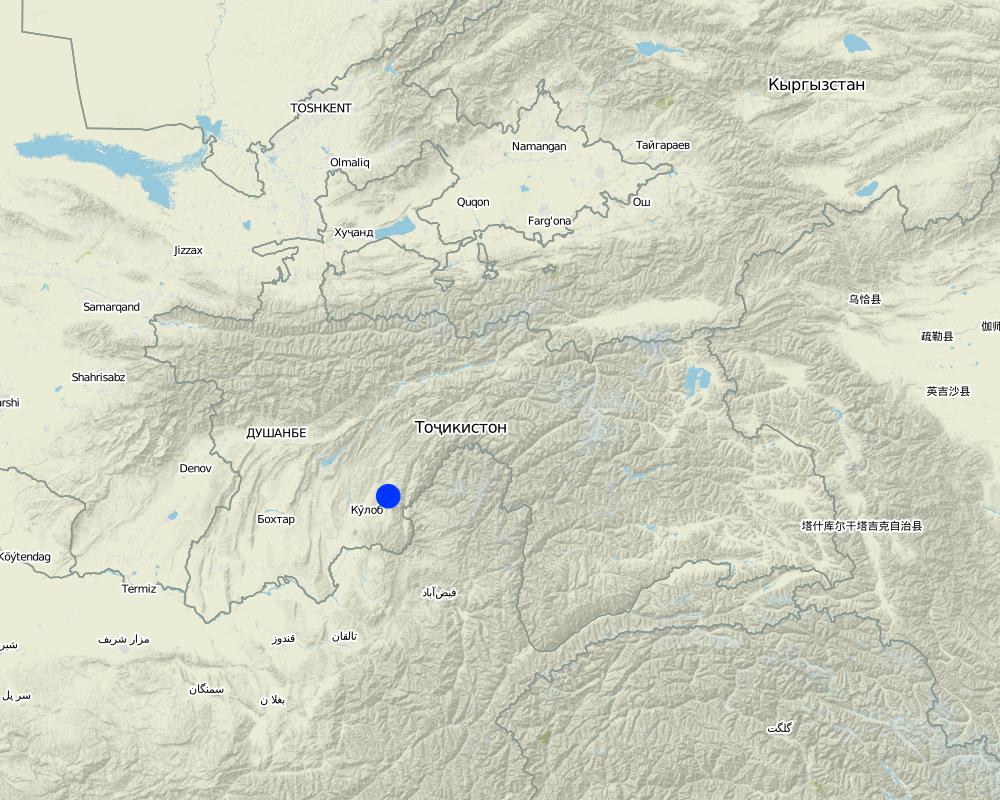Current agroforesty of an apple orchard with wheat cropping [塔吉克斯坦]
- 创建:
- 更新:
- 编制者: Malgorzata Conder
- 编辑者: –
- 审查者: Fabian Ottiger, Alexandra Gavilano
technologies_1172 - 塔吉克斯坦
查看章节
全部展开 全部收起1. 一般信息
1.2 参与该技术评估和文件编制的资源人员和机构的联系方式
有助于对技术进行记录/评估的机构名称(如相关)
CDE Centre for Development and Environment (CDE Centre for Development and Environment) - 瑞士1.3 关于使用通过WOCAT记录的数据的条件
编制者和关键资源人员接受有关使用通过WOCAT记录数据的条件。:
是
2. SLM技术的说明
2.1 技术简介
技术定义:
Agroforestry of an old apple orchard with wheat cropping
2.2 技术的详细说明
说明:
The farmer grows red, yellow and white apples in his orchard of 3.75 ha. Wheat is growing in the slightly pronounced terraces and recently some vines were planted this year. The rain fed orchard lies in the low part of the middle zone and has a slight slope. The absence of control and fence results in broken branches and trampled parts in the plot. The farmer is sharing the property with his four brothers, who inherited the property from their father in 1993 or 1994. The orchard was established during Soviet time in 1988. The government paid for the material and the farmer’s family did the labour. The government paid them for that input by crop yield. In addition to the orchard the farmer sewed wheat between the rows several years ago which adds up to a hectare of wheat crop in total. In the current year (2012), the workload and the yield have been very small. As there was heavy rainfall in spring, the farmer did not see the need to loose soil around the trees. The already old fruit trees gave low yield and, because of a hale storm, apples were destroyed.
Purpose of the Technology: Initially the government planned to manage land and make it more profitable by establishing orchards. Due to that intention the farmer’s family had work, subsistent crop and cash crops. Today the main source of income is the remittances from the sons who work in Russia. The farmer works part time as a taxi driver. The orchard lost its importance of main income.
Establishment / maintenance activities and inputs: At the time of the establishment of the fruit trees, the Soviet government paid for the seedlings and tractor fuel. Labour was done by the farmer, his brothers and their parents. The whole family worked for two years to build the orchard because they only had the possibility to work in the evenings and on weekends. Nowadays it is still a part time job for the farmer. Maintenance activities consist of ploughing, occasional soil loosening around the trees, pruning and harvesting apples and wheat. The wheat is cut by hand, which is very hard work. Because of heavy rainfalls last spring no soil was loosened. There is nobody to protect the orchard from grazing livestock.
Natural / human environment: The orchard lies on a foothill in the middle zone, close to the settlements of the valley. The apples trees are growing in rows on small terraces built by ploughing for years. Down- and upwards there are also orchards growing, all delimited laterally by the riverbed and a road. On one side of the plot a gully is developing rapidly. All of the neighbouring orchards seem to have a lack of maintenance and control. The orchards lying above but not far away from the settlements are accessible by car and tractor.
2.3 技术照片
2.5 已应用该技术的、本评估所涵盖的国家/地区/地点
国家:
塔吉克斯坦
区域/州/省:
Khatlon, Tajikistan
有关地点的进一步说明:
Muminabad
具体说明该技术的分布:
- 均匀地分布在一个区域
如果不知道精确的区域,请注明大致覆盖的区域:
- < 0.1 平方千米(10 公顷)
注释:
Total area covered by the SLM Technology is 3.75 km2.
Property belongs to five sons
Map
×2.6 实施日期
如果不知道确切的年份,请说明大概的日期:
- 10-50年前
2.7 技术介绍
详细说明该技术是如何引入的:
- 通过项目/外部干预
注释(项目类型等):
in 1988 orchard was established, since 1993 or 1994 the orchard belongs to the farmer and his four brothers
3. SLM技术的分类
3.1 该技术的主要目的
- 改良生产
- 减少、预防、恢复土地退化
3.2 应用该技术的当前土地利用类型
同一土地单元内混合使用的土地::
是
具体说明混合土地使用(作物/放牧/树木):
- 农林业

农田
- 一年一作
- 乔木与灌木的种植
年作 - 具体指明作物:
- 谷类 - 小麦(春季)
乔木和灌木种植 - 指定作物:
- 水果、其他
- 仁果类(苹果、梨子、柑橘等)
每年的生长季节数:
- 1
具体说明:
Longest growing period in days: 180 Longest growing period from month to month: March to September

牧场

森林/林地
注释:
Major land use problems (compiler’s opinion): Low soil nutrients and moisture
A lot of bare, compacted and trampled soil which impedes a high infiltration rate
Not sufficiently maintained orchard, incorrectly prouned fruit trees
Deep rill through the middle of the plot
Major land use problems (land users’ perception): Soil is leached out
Fruit trees are old and hence don't give a high yield
Water is only seasonally available
Low infiltration
Livestock is grazing on crop residues
3.4 供水
该技术所应用土地的供水:
- 雨养
3.5 该技术所属的SLM组
- 农业林学
3.6 包含该技术的可持续土地管理措施

农艺措施
- A1:植被和土壤覆盖层

植物措施
- V1:乔木和灌木覆盖层
注释:
Type of agronomic measures: mixed cropping / intercropping, contour tillage
3.7 该技术强调的主要土地退化类型

土壤水蚀
- Wg:冲沟侵蚀/沟蚀
- Wo:场外劣化效应

化学性土壤退化
- Cn:肥力下降和有机质含量下降(非侵蚀所致)

物理性土壤退化
- Pc:压实

生物性退化
- Bc:植被覆盖的减少
注释:
Main type of degradation addressed: Pc: compaction, Bc: reduction of vegetation cover
Secondary types of degradation addressed: Wg: gully erosion / gullying, Wo: offsite degradation effects, Cn: fertility decline and reduced organic matter content
Main causes of degradation: soil management, crop management (annual, perennial, tree/shrub)
Secondary causes of degradation: overgrazing, Heavy / extreme rainfall (intensity/amounts) (low infiltration rate and heava rainfalls cause rill formation)
4. 技术规范、实施活动、投入和成本
4.1 该技术的技术图纸
技术规范(与技术图纸相关):
The rows with the apple trees are not contour lined, reason why the plot counts 11 rows from one and 13 rows from the other side. The fruit trees grow with a distance of 6 metres to each other. Up to 30 trees were in a row, but due to drying or cutting out (shown in the drawing as "no trees") there are currently some 20 to 25 trees per row in average. Wheat is growing between the rows, mechanical plowing built some terrace-like relief as seen in the profile and sequency "A". A rill dominates the orchard where run off is drained.
Location: Chukurak watershed. Muminabad, Khatlon, Tajikistan
Technical knowledge required for field staff / advisors: high
Technical knowledge required for land users: high
Mixed cropping / intercropping
Material/ species: wheat intercropped in an orchard
作者:
Conder Malgorzata
4.2 有关投入和成本计算的一般信息
其它/国家货币(具体说明):
Somoni
如相关,注明美元与当地货币的汇率(例如1美元=79.9巴西雷亚尔):1美元=:
4.83
注明雇用劳工的每日平均工资成本:
12.40
4.3 技术建立活动
| 活动 | 时间(季度) | |
|---|---|---|
| 1. | Buying, transporting and planting trees (5 TJS and 20 min for plantin per tree) | once, spring, in 1988 |
4.4 技术建立所需要的费用和投入
| 对投入进行具体说明 | 单位 | 数量 | 单位成本 | 每项投入的总成本 | 土地使用者承担的成本% | |
|---|---|---|---|---|---|---|
| 劳动力 | Buying, transporting and planting tree | person days | 50.0 | 12.422 | 621.1 | 100.0 |
| 设备 | Machine use | Days | 1.0 | 16.6 | 16.6 | |
| 植物材料 | Seedlings | Seedlings | 1200.0 | 1.03516666 | 1242.2 | |
| 技术建立所需总成本 | 1879.9 | |||||
| 技术建立总成本,美元 | 389.21 | |||||
注释:
Duration of establishment phase: 24 month(s)
4.5 维护/经常性活动
| 活动 | 时间/频率 | |
|---|---|---|
| 1. | Plowing, 6 hours, 1 person | spring since 1988 |
| 2. | Sowing, 3 hours, 1 person | once a year |
| 3. | Cutting wheat manually by, 1 week (7h/day) 6 pers | once a year, autumn |
| 4. | Soil loosening (it was not done in 2012) | once a year, spring |
| 5. | Pruning (it was not done in 2012) | every tree once in 3 years |
| 6. | Harvesting apples (1000) | once a year, autumn |
4.6 维护/经常性活动所需要的费用和投入(每年)
| 对投入进行具体说明 | 单位 | 数量 | 单位成本 | 每项投入的总成本 | 土地使用者承担的成本% | |
|---|---|---|---|---|---|---|
| 劳动力 | Plowing | Person days | 0.75 | 12.4 | 9.3 | 100.0 |
| 劳动力 | Sowing | Person days | 0.375 | 12.4 | 4.65 | 100.0 |
| 劳动力 | Cutting wheat manually | Person days | 36.75 | 12.4 | 455.7 | 100.0 |
| 劳动力 | Soil loosening | Trees | 1000.0 | 0.1941 | 194.1 | 100.0 |
| 设备 | Petrol | liters | 40.0 | 1.1375 | 45.5 | 100.0 |
| 设备 | Machine use | Hours | 3.0 | 6.9 | 20.7 | 100.0 |
| 植物材料 | Seeds | Kg | 200.0 | 0.414 | 82.8 | 100.0 |
| 其它 | Pruning | Trees | 400.0 | 0.711 | 284.4 | 100.0 |
| 其它 | Harvesting apples | Apples | 1000.0 | 0.7453 | 745.3 | 100.0 |
| 技术维护所需总成本 | 1842.45 | |||||
| 技术维护总成本,美元 | 381.46 | |||||
注释:
Establishment phase: Seedlings and transport were paid by the government, planting was done by the farmer and his family. Labor (recurrent activity(3))for apple harvesting calculated according to T_TAJ013.
4.7 影响成本的最重要因素
描述影响成本的最决定性因素:
Labour affects the cost the most, secondly the seedlings (which were subsidised).
5. 自然和人文环境
5.1 气候
年降雨量
- < 250毫米
- 251-500毫米
- 501-750毫米
- 751-1,000毫米
- 1,001-1,500毫米
- 1,501-2,000毫米
- 2,001-3,000毫米
- 3,001-4,000毫米
- > 4,000毫米
有关降雨的规范/注释:
Totally 800 mm: 700mm in winter-spring, July-Sept dry season
农业气候带
- 半湿润
Thermal climate class: temperate, LPG from end of March until September
5.2 地形
平均坡度:
- 水平(0-2%)
- 缓降(3-5%)
- 平缓(6-10%)
- 滚坡(11-15%)
- 崎岖(16-30%)
- 陡峭(31-60%)
- 非常陡峭(>60%)
地形:
- 高原/平原
- 山脊
- 山坡
- 山地斜坡
- 麓坡
- 谷底
垂直分布带:
- 0-100 m a.s.l.
- 101-500 m a.s.l.
- 501-1,000 m a.s.l.
- 1,001-1,500 m a.s.l.
- 1,501-2,000 m a.s.l.
- 2,001-2,500 m a.s.l.
- 2,501-3,000 m a.s.l.
- 3,001-4,000 m a.s.l.
- > 4,000 m a.s.l.
5.3 土壤
平均土层深度:
- 非常浅(0-20厘米)
- 浅(21-50厘米)
- 中等深度(51-80厘米)
- 深(81-120厘米)
- 非常深(> 120厘米)
土壤质地(表土):
- 中粒(壤土、粉土)
- 细粒/重质(粘土)
如有可能,附上完整的土壤描述或具体说明可用的信息,例如土壤类型、土壤酸碱度、阳离子交换能力、氮、盐度等。:
Soil fertility: Low
Soil drainage/infiltration: Poor
Soil water storage capacity: Low
5.4 水资源可用性和质量
地表水的可用性:
匮乏/没有
水质(未处理):
仅供农业使用(灌溉)
5.5 生物多样性
物种多样性:
- 低
5.6 应用该技术的土地使用者的特征
生产系统的市场定位:
- 生计(自给)
非农收入:
- > 收入的50%
相对财富水平:
- 平均水平
个人或集体:
- 个人/家庭
机械化水平:
- 手工作业
- 机械化/电动
性别:
- 男人
说明土地使用者的其他有关特征:
Land users applying the Technology are mainly common / average land users
Population density: 100-200 persons/km2
Annual population growth: 1% - 2%
Off-farm income specification: The farmer is working mainly as taxi driver
Level of mechanization: Manual labour (ranked 1, sowing, harvesting, soil losening) and mechanised (ranked 2, plowing)
5.7 应用该技术的土地使用者使用的平均土地面积
- < 0.5 公顷
- 0.5-1 公顷
- 1-2 公顷
- 2-5公顷
- 5-15公顷
- 15-50公顷
- 50-100公顷
- 100-500公顷
- 500-1,000公顷
- 1,000-10,000公顷
- > 10,000公顷
这被认为是小规模、中规模还是大规模的(参照当地实际情况)?:
- 小规模的
注释:
2.06 ha (household 7.7 members)
5.8 土地所有权、土地使用权和水使用权
土地所有权:
- 个人,有命名
土地使用权:
- 租赁
用水权:
- 社区(有组织)
5.9 进入服务和基础设施的通道
健康:
- 贫瘠
- 适度的
- 好
教育:
- 贫瘠
- 适度的
- 好
技术援助:
- 贫瘠
- 适度的
- 好
就业(例如非农):
- 贫瘠
- 适度的
- 好
市场:
- 贫瘠
- 适度的
- 好
能源:
- 贫瘠
- 适度的
- 好
道路和交通:
- 贫瘠
- 适度的
- 好
饮用水和卫生设施:
- 贫瘠
- 适度的
- 好
金融服务:
- 贫瘠
- 适度的
- 好
6. 影响和结论性说明
6.1 该技术的现场影响
社会经济效应
生产
作物生产
注释/具体说明:
middle-term increase however possibility of lower harvest due to lack of maintenance
收入和成本
农业收入
注释/具体说明:
not on short-term, low harvest if maintenance is done poorly.
工作量
注释/具体说明:
Less mainetnance work
社会文化影响
食品安全/自给自足
注释/具体说明:
low harvest, but it is not the only source of income
生态影响
水循环/径流
水量
注释/具体说明:
Difficult to compare established orchard with szenario without orchard
地表径流
土壤
土壤水分
土壤覆盖层
土壤结壳/密封
土壤压实
土壤有机物/地下C
减少气候和灾害风险
风速
6.2 该技术的场外影响已经显现
下游洪水
缓冲/过滤能力
6.3 技术对渐变气候以及与气候相关的极端情况/灾害的暴露和敏感性(土地使用者认为的极端情况/灾害)
渐变气候
渐变气候
| 季节 | 增加或减少 | 该技术是如何应对的? | |
|---|---|---|---|
| 年温度 | 增加 | 不好 |
气候有关的极端情况(灾害)
气象灾害
| 该技术是如何应对的? | |
|---|---|
| 局地暴雨 | 不好 |
| 局地风暴 | 未知 |
气候灾害
| 该技术是如何应对的? | |
|---|---|
| 干旱 | 不好 |
水文灾害
| 该技术是如何应对的? | |
|---|---|
| 比较和缓的(河道)洪水 | 不好 |
其他气候相关的后果
其他气候相关的后果
| 该技术是如何应对的? | |
|---|---|
| 缩短生长期 | 不好 |
6.7 该技术的优点/长处/机会
| 土地使用者眼中的长处/优势/机会 |
|---|
|
Increase of productivity of the land by establishing an orchard. How can they be sustained / enhanced? Give more power and knowledge to farmers to raise responsability for the crops. |
| 编制者或其他关键资源人员认为的长处/优势/机会 |
|---|
|
Land management is right if maintenance and technical assistence are warranted. How can they be sustained / enhanced? Support of establishment and recurrent activities is important. |
6.8 技术的弱点/缺点/风险及其克服方法
| 土地使用者认为的弱点/缺点/风险 | 如何克服它们? |
|---|---|
| Old trees. | Plant new ones. |
| 编制者或其他关键资源人员认为的弱点/缺点/风险 | 如何克服它们? |
|---|---|
| Orchard is not well maintained (sporadical soil loosening, pruning, control). | Knowledge transfer with e.g. demonstration of well maintained orchards and round tables to share farming experiences. |
| Support shoulb not only focus on the establishment phase (by provdiding funds) but also in a long-term providing cultivation knowledge. |
7. 参考和链接
7.1 信息的方法/来源
链接和模块
全部展开 全部收起链接
无链接
模块
无模块





